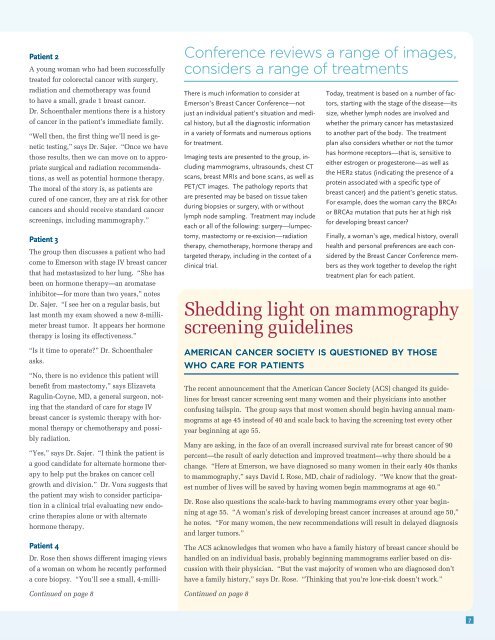Emerson Hospital
1U3T81d
1U3T81d
Create successful ePaper yourself
Turn your PDF publications into a flip-book with our unique Google optimized e-Paper software.
Patient 2<br />
A young woman who had been successfully<br />
treated for colorectal cancer with surgery,<br />
radiation and chemotherapy was found<br />
to have a small, grade 1 breast cancer.<br />
Dr. Schoenthaler mentions there is a history<br />
of cancer in the patient’s immediate family.<br />
“Well then, the first thing we’ll need is genetic<br />
testing,” says Dr. Sajer. “Once we have<br />
those results, then we can move on to appropriate<br />
surgical and radiation recommendations,<br />
as well as potential hormone therapy.<br />
The moral of the story is, as patients are<br />
cured of one cancer, they are at risk for other<br />
cancers and should receive standard cancer<br />
screenings, including mammography.”<br />
Patient 3<br />
The group then discusses a patient who had<br />
come to <strong>Emerson</strong> with stage IV breast cancer<br />
that had metastasized to her lung. “She has<br />
been on hormone therapy—an aromatase<br />
inhibitor—for more than two years,” notes<br />
Dr. Sajer. “I see her on a regular basis, but<br />
last month my exam showed a new 8-millimeter<br />
breast tumor. It appears her hormone<br />
therapy is losing its effectiveness.”<br />
“Is it time to operate?” Dr. Schoenthaler<br />
asks.<br />
“No, there is no evidence this patient will<br />
benefit from mastectomy,” says Elizaveta<br />
Ragulin-Coyne, MD, a general surgeon, noting<br />
that the standard of care for stage IV<br />
breast cancer is systemic therapy with hormonal<br />
therapy or chemotherapy and possibly<br />
radiation.<br />
“Yes,” says Dr. Sajer. “I think the patient is<br />
a good candidate for alternate hormone therapy<br />
to help put the brakes on cancer cell<br />
growth and division.” Dr. Vora suggests that<br />
the patient may wish to consider participation<br />
in a clinical trial evaluating new endocrine<br />
therapies alone or with alternate<br />
hormone therapy.<br />
Patient 4<br />
Dr. Rose then shows different imaging views<br />
of a woman on whom he recently performed<br />
a core biopsy. “You’ll see a small, 4-milli-<br />
Continued on page 8<br />
Conference reviews a range of images,<br />
considers a range of treatments<br />
There is much information to consider at<br />
<strong>Emerson</strong>’s Breast Cancer Conference—not<br />
just an individual patient’s situation and medical<br />
history, but all the diagnostic information<br />
in a variety of formats and numerous options<br />
for treatment.<br />
Imaging tests are presented to the group, including<br />
mammograms, ultrasounds, chest CT<br />
scans, breast MRIs and bone scans, as well as<br />
PET/CT images. The pathology reports that<br />
are presented may be based on tissue taken<br />
during biopsies or surgery, with or without<br />
lymph node sampling. Treatment may include<br />
each or all of the following: surgery—lumpectomy,<br />
mastectomy or re-excision—radiation<br />
therapy, chemotherapy, hormone therapy and<br />
targeted therapy, including in the context of a<br />
clinical trial.<br />
Shedding light on mammography<br />
screening guidelines<br />
The recent announcement that the American Cancer Society (ACS) changed its guidelines<br />
for breast cancer screening sent many women and their physicians into another<br />
confusing tailspin. The group says that most women should begin having annual mammograms<br />
at age 45 instead of 40 and scale back to having the screening test every other<br />
year beginning at age 55.<br />
Many are asking, in the face of an overall increased survival rate for breast cancer of 90<br />
percent—the result of early detection and improved treatment—why there should be a<br />
change. “Here at <strong>Emerson</strong>, we have diagnosed so many women in their early 40s thanks<br />
to mammography,” says David I. Rose, MD, chair of radiology. “We know that the greatest<br />
number of lives will be saved by having women begin mammograms at age 40.”<br />
Dr. Rose also questions the scale-back to having mammograms every other year beginning<br />
at age 55. “A woman’s risk of developing breast cancer increases at around age 50,”<br />
he notes. “For many women, the new recommendations will result in delayed diagnosis<br />
and larger tumors.”<br />
The ACS acknowledges that women who have a family history of breast cancer should be<br />
handled on an individual basis, probably beginning mammograms earlier based on discussion<br />
with their physician. “But the vast majority of women who are diagnosed don’t<br />
have a family history,” says Dr. Rose. “Thinking that you’re low-risk doesn’t work.”<br />
Continued on page 8<br />
Today, treatment is based on a number of factors,<br />
starting with the stage of the disease—its<br />
size, whether lymph nodes are involved and<br />
whether the primary cancer has metastasized<br />
to another part of the body. The treatment<br />
plan also considers whether or not the tumor<br />
has hormone receptors—that is, sensitive to<br />
either estrogen or progesterone—as well as<br />
the HER2 status (indicating the presence of a<br />
protein associated with a specific type of<br />
breast cancer) and the patient’s genetic status.<br />
For example, does the woman carry the BRCA1<br />
or BRCA2 mutation that puts her at high risk<br />
for developing breast cancer?<br />
Finally, a woman’s age, medical history, overall<br />
health and personal preferences are each considered<br />
by the Breast Cancer Conference members<br />
as they work together to develop the right<br />
treatment plan for each patient.<br />
american cancer society is questioned by those<br />
who care for patients<br />
7


